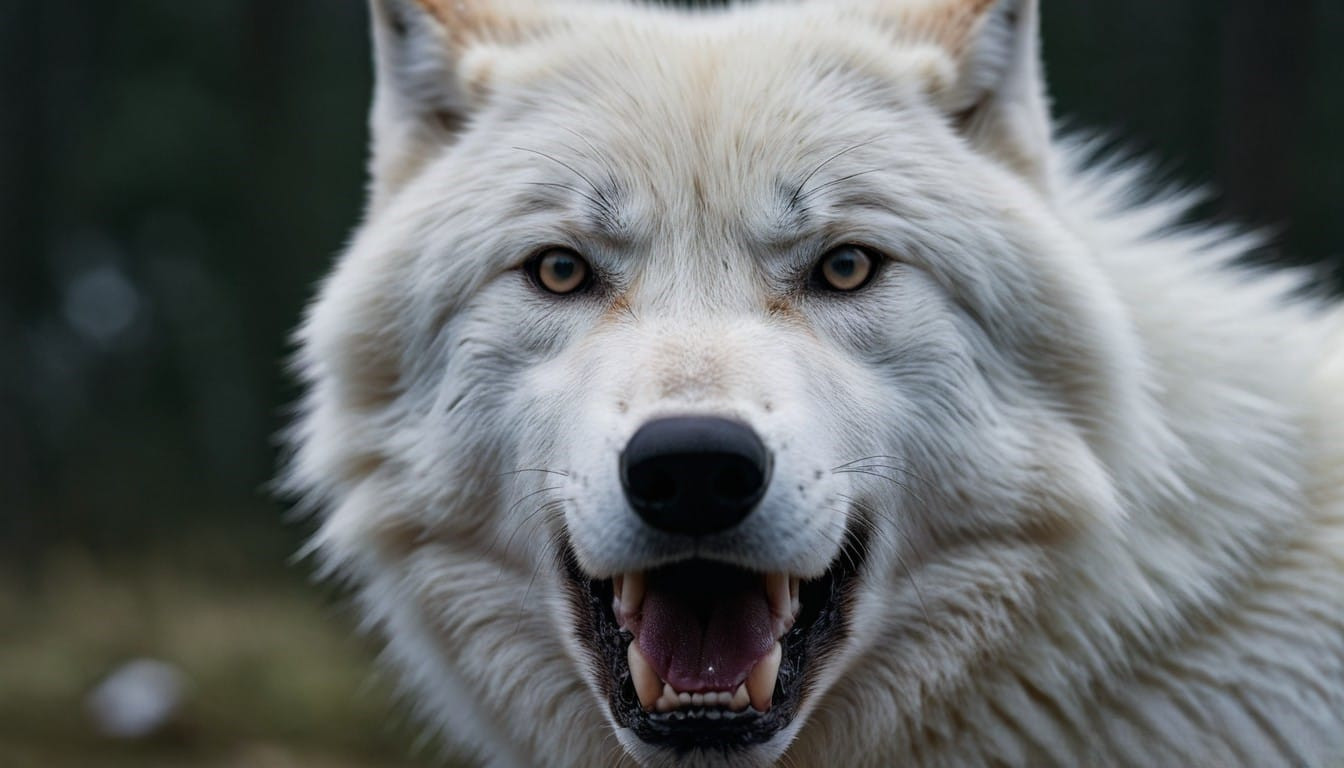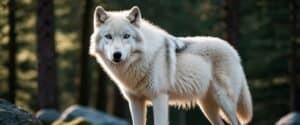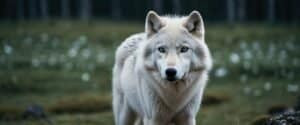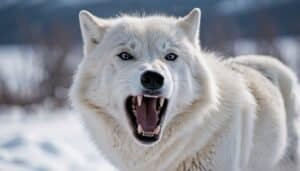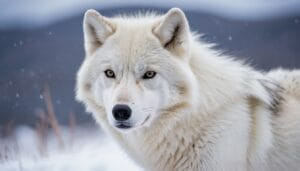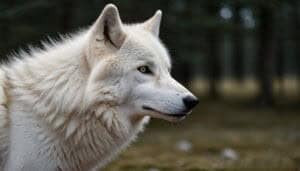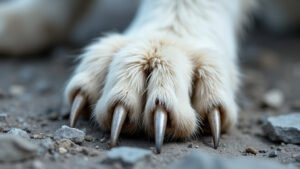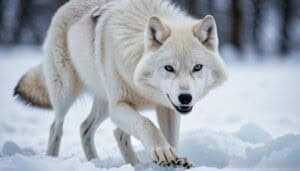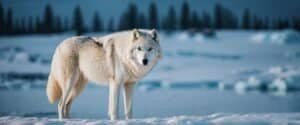Introduction
Arctic wolves are fascinating creatures with unique adaptations that enable them to survive in the harsh environments of the Arctic. This article explores the dental structure of Arctic wolves, including the number of teeth they have and their specific functions
We will delve into how their teeth are adapted for hunting and feeding, the development of their teeth from pups to adults, and common dental issues they might face. By understanding these aspects, we gain insight into the remarkable survival strategies of the Arctic wolf
Dental Formula and Structure of an Arctic Wolf
Arctic wolves, like other members of the Canidae family, have a specific dental structure adapted to their carnivorous diet and lifestyle. Their teeth play crucial roles in capturing and processing prey, reflecting their predatory nature
Understanding the Dental Formula
The dental formula is a shorthand representation of the number and types of teeth in an animal’s mouth. For an Arctic wolf, the dental formula is typically written as: 3.1.4.2 / 3.1.4.3
This formula indicates that in one half of the upper jaw, an Arctic wolf has 3 incisors, 1 canine, 4 premolars, and 2 molars. In one half of the lower jaw, it has 3 incisors, 1 canine, 4 premolars, and 3 molars. Multiplying these by two (for the other half of the mouth) gives a total of 42 teeth
Structure and Types of Teeth
Arctic wolves have four main types of teeth: incisors, canines, premolars, and molars, each with a specific function:
Incisors: The six small front teeth (three on each side of both jaws) are used primarily for nipping and grasping. These teeth are crucial for grooming and manipulating small pieces of food
Canines: The four long, pointed teeth (one on each side of both jaws) are essential for holding and killing prey. These teeth are powerful and designed to penetrate deeply into flesh
Premolars: The sixteen teeth located behind the canines (four on each side of both jaws) help in tearing and shearing meat. These teeth have sharp edges and are instrumental in cutting through flesh
Molars: The ten teeth at the back of the mouth (two on each side of the upper jaw and three on each side of the lower jaw) are used for grinding and crushing bones. These are the largest and most robust teeth, capable of handling tough material
Comparison with Other Wolves
While the dental formula of an Arctic wolf is similar to other gray wolves, subtle differences exist that reflect their adaptation to the Arctic environment. For instance, Arctic wolves tend to have slightly larger canines and molars, which are beneficial for hunting and consuming the larger prey typical in their habitat, such as musk oxen and Arctic hares
Comparatively, wolves living in temperate regions might have slightly different wear patterns on their teeth due to the different types of prey and environmental conditions they encounter. These differences, though minor, highlight the adaptability and evolutionary nuances within the species
Functions and Adaptations of Arctic Wolf Teeth
Arctic wolf teeth are specialized tools that play critical roles in their survival. These teeth are not only essential for hunting and feeding but also exhibit unique adaptations that help the wolves thrive in their harsh environment
Incisors, Canines, Premolars, and Molars
Each type of tooth in an Arctic wolf’s mouth serves a distinct purpose:
Incisors: The primary function of the incisors is to nip and grasp small items. These teeth are crucial for grooming and removing parasites or debris from the fur. They are also used to delicately pick up pieces of meat, bones, or other objects
Canines: The canines are the most prominent and vital teeth for an Arctic wolf. They are used to capture and kill prey by delivering deep, penetrating bites. The sharp and elongated canines can tear flesh efficiently, making them indispensable during hunting
Premolars: These teeth are designed for shearing meat. The sharp edges of the premolars act like scissors, allowing the wolf to cut through muscle and sinew. This function is critical for consuming prey quickly and efficiently, reducing the risk of losing food to scavengers
Molars: The molars, particularly in the lower jaw, are robust and well-suited for crushing bones. This ability to break bones allows Arctic wolves to access marrow, a nutrient-rich part of their diet. The molars’ grinding action is also essential for processing tough materials, ensuring that the wolves can derive maximum nutrition from their food
Role in Hunting and Feeding
Arctic wolves rely heavily on their teeth for hunting, which is central to their survival. Their hunting strategy typically involves working in packs to take down large prey, such as caribou or musk oxen. The wolves use their canines to latch onto and immobilize the prey, often targeting the throat or neck to deliver a fatal bite
Once the prey is subdued, the wolves use their premolars and molars to tear apart and consume the meat. The efficiency of their teeth allows them to quickly process the prey, which is crucial in the Arctic where scavengers like polar bears and other wolves can pose a threat to their kill
Environmental Adaptations
The teeth of Arctic wolves have evolved specific adaptations to help them survive in the extreme conditions of their habitat. One such adaptation is the larger size of their canines and molars compared to other wolves. These larger teeth provide the strength needed to tackle and process large prey typical of the Arctic environment
Additionally, the wear patterns on their teeth often reflect the rough nature of their diet, which includes not only flesh but also bones and sometimes even frozen meat. The ability to process such tough materials is a vital adaptation that ensures they can obtain the necessary nutrients year-round, even when prey is scarce
Diet and Dental Health
The diet of Arctic wolves, which primarily consists of large herbivores like musk oxen, caribou, and Arctic hares, has a significant impact on their dental health. The consumption of bones helps keep their teeth clean by scraping away plaque, but it also causes considerable wear. Despite this, the robust nature of their teeth ensures they can handle the wear and tear of their diet
However, Arctic wolves can still face dental issues such as broken teeth, which can result from hunting large, strong prey or gnawing on bones. Such dental problems can affect their ability to feed and, consequently, their overall health. Despite these challenges, the evolutionary adaptations of their teeth generally provide the resilience needed to survive in their demanding environment
Development and Health of Arctic Wolf Teeth
The development and health of Arctic wolf teeth are critical aspects of their biology, affecting their ability to hunt and process food throughout their lives. Understanding how their teeth develop from pups to adults and the common dental issues they may face provides insight into the life cycle of these remarkable animals
Teeth Development from Pups to Adults
Arctic wolf pups are born toothless, and their dental development follows a specific timeline:
Neonatal Stage (0-2 weeks): Pups are born without teeth and rely solely on their mother’s milk for nutrition
Primary Teeth Eruption (3-6 weeks): The first set of teeth, also known as deciduous or milk teeth, begin to emerge. These include the incisors, canines, and premolars. This set of 28 teeth allows the pups to start eating solid food as they transition from milk to meat
Permanent Teeth Eruption (4-7 months): As the pups grow, their primary teeth are gradually replaced by permanent teeth. This process starts around four months of age and is usually complete by seven months. The full adult set of 42 teeth includes incisors, canines, premolars, and molars
The development of strong, healthy teeth is essential for young wolves as they learn to hunt and fend for themselves. Proper nutrition during the early stages is crucial for ensuring that their teeth develop correctly
Common Dental Issues
Arctic wolves, like all animals, can experience a range of dental issues that can impact their health and survival:
Tooth Fractures: Due to their diet, which includes hard bones and tough meat, Arctic wolves are prone to tooth fractures. These injuries can occur during hunting or while gnawing on bones. Fractured teeth can lead to pain, infection, and difficulty eating
Tooth Wear: The constant use of their teeth for processing tough food results in natural wear over time. While some wear is normal, excessive wear can lead to dental problems such as exposure of the tooth pulp, which can cause pain and infection
Periodontal Disease: This condition affects the gums and structures supporting the teeth. It can be caused by bacterial infections due to food particles trapped in the gum line. Periodontal disease can lead to tooth loss and systemic health issues if left untreated
Tooth Decay: Although less common in wild animals compared to domestic ones, tooth decay can occur, especially if there is a lack of sufficient abrasive food that naturally cleans the teeth
Importance of Dental Health
Maintaining dental health is vital for Arctic wolves. Healthy teeth ensure they can efficiently hunt and consume prey, which is crucial for their survival in the harsh Arctic environment. Dental issues can significantly impact their ability to feed, ultimately affecting their overall health and longevity
Researchers and wildlife veterinarians often study the teeth of Arctic wolves to gain insights into their diet, health, and behavior. Dental examinations can reveal information about an individual wolf’s age, diet, and even the environmental conditions they have experienced
Conclusion
Arctic wolves, with their 42 specialized teeth, showcase a remarkable example of evolutionary adaptation to the Arctic environment. Their dental formula, including incisors, canines, premolars, and molars, highlights the specific roles each type of tooth plays in their survival. These teeth are essential for hunting, feeding, and maintaining overall health, reflecting their predatory lifestyle and dietary needs
The functions and adaptations of Arctic wolf teeth are integral to their ability to thrive in the harsh Arctic conditions. Each type of tooth has a distinct purpose, from capturing and killing prey to processing tough materials like bones. The adaptations of their teeth to the environment, diet, and wear patterns further emphasize their evolutionary success
The development and health of Arctic wolf teeth are equally important. Starting from toothless pups to the development of a full set of adult teeth, every stage is crucial for their survival. Understanding the common dental issues they face, such as tooth fractures, wear, and periodontal disease, helps us appreciate the challenges these animals endure
